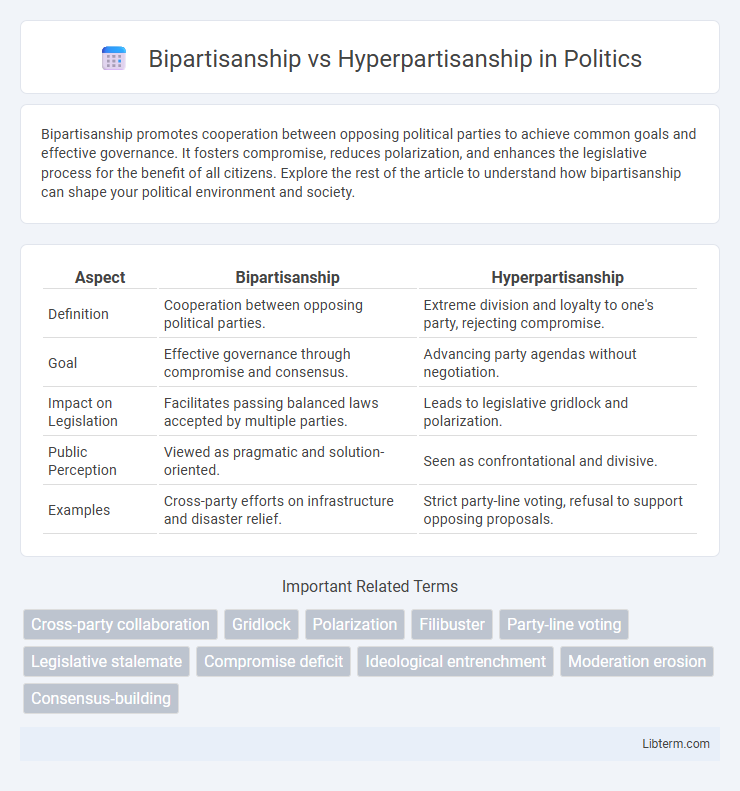Bipartisanship promotes cooperation between opposing political parties to achieve common goals and effective governance. It fosters compromise, reduces polarization, and enhances the legislative process for the benefit of all citizens. Explore the rest of the article to understand how bipartisanship can shape your political environment and society.
Table of Comparison
| Aspect | Bipartisanship | Hyperpartisanship |
|---|---|---|
| Definition | Cooperation between opposing political parties. | Extreme division and loyalty to one's party, rejecting compromise. |
| Goal | Effective governance through compromise and consensus. | Advancing party agendas without negotiation. |
| Impact on Legislation | Facilitates passing balanced laws accepted by multiple parties. | Leads to legislative gridlock and polarization. |
| Public Perception | Viewed as pragmatic and solution-oriented. | Seen as confrontational and divisive. |
| Examples | Cross-party efforts on infrastructure and disaster relief. | Strict party-line voting, refusal to support opposing proposals. |
Understanding Bipartisanship: Definition and Importance
Bipartisanship involves cooperation and compromise between opposing political parties to achieve common legislative goals, fostering stable governance and effective policy-making. It is crucial for passing comprehensive laws that reflect diverse perspectives, reducing political gridlock and promoting national unity. Understanding bipartisanship aids in recognizing its role in enhancing democratic processes and addressing complex societal challenges collaboratively.
Hyperpartisanship: What It Means and How It Emerged
Hyperpartisanship refers to an extreme form of political loyalty where individuals or groups exhibit unwavering support for their party, often at the expense of bipartisan cooperation or compromise. This phenomenon emerged due to increasing ideological polarization, media echo chambers, and strategic political maneuvering that incentivize divisiveness rather than consensus. The consequences of hyperpartisanship include legislative gridlock, decreased public trust in government institutions, and heightened social polarization.
Historical Evolution of Political Collaboration in the U.S.
The historical evolution of political collaboration in the U.S. reveals a gradual shift from periods of bipartisanship, characterized by cooperative legislative efforts and mutual compromise, to an era marked by hyperpartisanship with increased polarization and legislative gridlock. Key moments such as the New Deal coalition in the 1930s and post-World War II consensus politics fostered bipartisan cooperation, while recent decades have seen intensified ideological divisions and party loyalty overwhelming cross-party collaboration. This shift reflects changing social dynamics, media influence, and electoral strategies that prioritize party unity and conflict over compromise.
Core Differences Between Bipartisanship and Hyperpartisanship
Bipartisanship involves collaboration and compromise between opposing political parties to achieve common legislative goals, emphasizing mutual respect and consensus-building. Hyperpartisanship, in contrast, is characterized by extreme political polarization where parties prioritize ideological purity and winning over cooperation, often leading to gridlock and heightened conflict. These core differences impact policy-making effectiveness and public trust in democratic institutions.
The Impact of Hyperpartisanship on Policy Making
Hyperpartisanship significantly impedes effective policymaking by fostering legislative gridlock and reducing the potential for compromise between political parties. This extreme loyalty to party ideology often results in polarized debates, where consensus-driven solutions become rare and policy implementations are delayed or blocked entirely. Consequently, hyperpartisanship undermines democratic governance by prioritizing party interests over bipartisan collaboration essential for addressing complex socio-economic issues.
Advantages of Bipartisan Approaches in Governance
Bipartisan approaches in governance foster collaboration between political parties, leading to more balanced and effective policymaking that reflects diverse perspectives. Such cooperation enhances legislative stability and reduces gridlock, enabling the passage of laws that address complex societal issues. By promoting mutual understanding and compromise, bipartisanship improves public trust and strengthens democratic institutions.
Social and Economic Consequences of Political Polarization
Political polarization marked by hyperpartisanship weakens social cohesion by fostering increased distrust and social fragmentation among citizens. Economic consequences include policy gridlock that hampers effective fiscal management and stifles economic growth due to delays in addressing critical issues like healthcare, infrastructure, and taxation reform. Bipartisanship promotes collaborative governance, enabling smoother passage of legislation that supports stable economic development and social stability.
Media Influence on Bipartisanship and Hyperpartisanship
Media influence significantly shapes bipartisanship and hyperpartisanship by framing political narratives that either encourage collaboration or deepen division. Balanced media outlets promote bipartisanship by highlighting cross-party cooperation and shared goals, fostering a more informed and less polarized public discourse. Conversely, hyperpartisan media amplify partisan conflicts and ideological differences, intensifying political polarization and reducing opportunities for bipartisan compromise.
Strategies for Promoting Bipartisanship in a Divided Landscape
Strategies for promoting bipartisanship in a divided landscape include fostering open communication channels between opposing parties to build trust and understanding. Implementing collaborative policymaking processes and bipartisan committees can encourage cooperation and reduce partisan gridlock. Encouraging shared goals and emphasizing common interests over ideological differences helps create a framework for sustainable political compromise.
The Future of American Politics: Can Bipartisanship Prevail?
The future of American politics hinges on the ability of bipartisanship to counteract the rising tide of hyperpartisanship that has polarized Congress and policymaking. Effective collaboration across party lines is essential for passing significant legislation and restoring public trust in government institutions. If bipartisan efforts can overcome entrenched ideological divisions, there is potential for a more functional and cooperative political environment.
Bipartisanship Infographic

 libterm.com
libterm.com